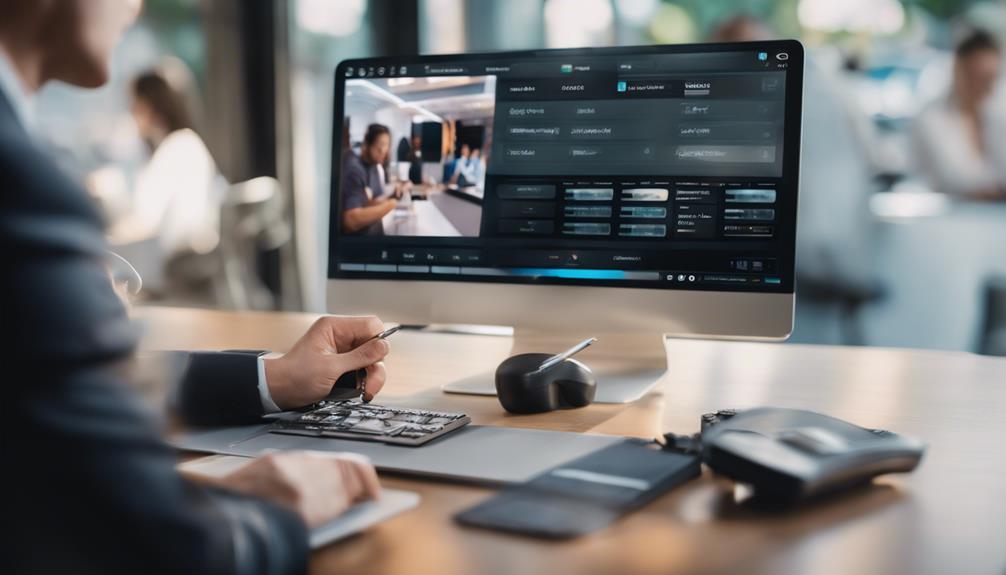To optimize transaction fees and enhance profitability, begin by choosing the right payment processor that aligns with your business needs. Evaluate cost structures, security features, and integration simplicity to make an informed decision. Negotiate lower transaction rates by leveraging transaction volume and understanding cost components. Implement interchange optimization strategies by analyzing fees, negotiating lower interchange rates, and utilizing data effectively. Consider leveraging dynamic currency conversion for added revenue and customer transparency. Consolidate payment methods to streamline operations, reduce fees, and improve profitability. These strategies can help you maximize profits through efficient fee management and strategic financial decisions.
Key Takeaways
- Leverage transaction volume for better rates.
- Understand interchange fee structure for negotiation.
- Utilize data analysis to reduce transaction fees.
- Explore special programs for cost savings.
- Focus on reducing interchange fees for profitability.
Choosing the Right Payment Processor

When selecting a payment processor, prioritize evaluating cost structures, security features, and integration simplicity. The choice of payment processors can have a big impact on your business's profitability optimization. Begin by examining the cost constructs offered by different providers. Compare transaction charges to make sure you're getting the most cost-effective option for your business.
Additionally, consider the security features each processor offers to safeguard your transactions and customer data.
Integration simplicity is another important factor to take into account. Opt for a payment processor that seamlessly integrates with your current systems to streamline operations. Conduct a comparative analysis based on transaction volume and size to determine which processor aligns best with your business needs and goals.
If you're already working with a payment processor, leverage this information to negotiate better rates with your current providers. By carefully evaluating these aspects of payment processors, you can set your business up for success in fee structures and overall financial efficiency.
Negotiating Lower Transaction Rates

To optimize your profitability and reduce transaction costs, consider negotiating lower rates with your payment service providers. By leveraging your transaction volume and industry benchmarks, you can negotiate better rates that will help lower your overall transaction expenses. Understanding the fee structures and cost components of transactions is essential for successful negotiations with payment processors. You should focus on negotiating lower interchange fees and exploring any special programs offered by your payment service providers to find opportunities for cost savings. Regularly reviewing your payment strategies and adjusting them accordingly can also help in optimizing your transaction fees for increased profitability.
| Key Points | Details | Tips |
|---|---|---|
| Negotiating Rates | Leverage transaction volume for better rates | Utilize industry benchmarks for negotiation |
| Fee Structures | Understand the cost components of transactions | Focus on reducing interchange fees |
| Special Programs | Explore special programs for cost savings | Take advantage of discounts offered |
Implementing Interchange Optimization Strategies

Implementing interchange optimization strategies can significantly reduce payment processing costs for businesses, especially in relation to card transactions where interchange fees can represent a substantial portion of total expenses.
To make payment processing more cost-efficient, it's essential to understand the interchange fee structure established by payment networks. By negotiating lower interchange fees with payment service providers, significant savings can be achieved.
Utilizing data analysis to identify opportunities for interchange optimization is key to boosting profitability. Interchange optimization involves analyzing transaction fees associated with card payments and finding ways to minimize these costs.
By implementing effective strategies, businesses can streamline their payment processes and enhance their bottom line. Remember, optimizing interchange fees is a proactive approach that requires continuous evaluation and adjustment to secure long-term financial benefits.
Stay informed about industry trends and work closely with payment service providers to leverage interchange optimization for sustainable cost savings and improved profitability.
Leveraging Dynamic Currency Conversion

By exploring the benefits of Dynamic Currency Conversion (DCC), businesses can enhance revenue streams and provide added transparency to customers in their payment transactions.
DCC allows customers to pay in their home currency during international transactions, offering them the convenience of seeing prices in a familiar currency.
Merchants can earn additional revenue by incorporating an exchange rate margin into the DCC process. This added margin, while transparent to customers, contributes to the profitability of the business.
The transparency provided by DCC by displaying the final amount in the customer's familiar currency before completing the transaction enhances the overall shopping experience.
Implementing DCC not only increases conversion rates but also reduces chargebacks by eliminating foreign exchange surprises for customers.
Consolidating Payment Methods for Savings

Consolidating payment methods enhances efficiency and reduces transaction fees for businesses. By focusing on a select few payment options, you can minimize processing costs and potentially negotiate better rates with payment service providers. Streamlining the payment process not only simplifies checkout for customers but also has the potential to improve conversion rates, ultimately boosting profitability.
Removing less popular or costly payment methods can lead to significant cost savings and enhance operational efficiency in payment processing. Utilizing data analysis to understand payment method usage can guide the consolidation process, helping you optimize transaction fees and maximize overall profitability.
Frequently Asked Questions
How to Reduce Transaction Costs?
To reduce transaction costs effectively, start by analyzing interchange fees and negotiating with payment providers for lower rates.
Implement fraud prevention tools and opt for local acquiring to minimize fees.
Utilize data analysis for optimized routing.
These steps can help lower costs and boost profitability.
How Can You Reduce the Cost of a Specific Payment Method?
To reduce the cost of a specific payment method, consider exploring alternate options like ACH payments or bank transfers, which often have lower fees.
Educate your customers on these cost-effective alternatives to influence their payment choices positively.
Analyze the impact of cryptocurrency transactions on processing expenses and adjust accordingly.
Providing incentives for selecting cheaper payment methods can further decrease overall processing costs.
Evaluating and adapting payment strategies can help optimize profitability.
What Is Payment Optimization?
Payment optimization involves strategically managing transaction fees to increase profitability. By focusing on reducing costs related to payment processing, businesses can streamline payment processes for efficiency and savings.
Analyzing and adjusting payment strategies can enhance revenue and profitability. Implementing advanced analytics and tools aids in optimizing transaction fees effectively, ultimately boosting your bottom line.
How Do Transaction Fees Work?
Transaction fees are charges applied by payment processors when processing transactions. They can be a percentage of the transaction amount, a fixed fee per transaction, or a mix of both. These fees are determined by the payment method utilized, like credit cards, debit cards, or e-wallets.
Understanding transaction fees is important for managing costs. By analyzing and negotiating with payment service providers, businesses can control expenses and enhance profitability.
Conclusion
To maximize your profitability, optimizing transaction fees is essential. By choosing the right payment processor, negotiating lower rates, implementing interchange optimization strategies, leveraging dynamic currency conversion, and consolidating payment methods, you can increase your bottom line.
Taking these steps won't only boost your profitability but also streamline your payment processes for a more efficient operation. Start implementing these strategies today to see a significant impact on your business's financial health.










